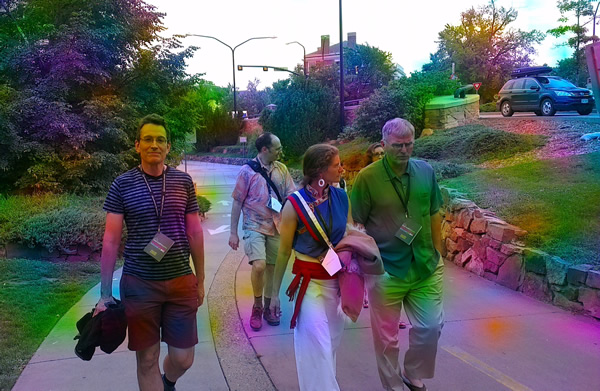
I’m just back from the 2012 Buddhist Geeks Conference. It was Big Fun.
This is a picture, taken by Hokai Sobol, of spontaneously manifesting geek thiglés.
Geek thiglés can self-manifest when you get critical mass of geekery in close proximity. The picture, left to right, shows me, Daniel Ingram, Rin’dzin Pamo, and Ken McLeod. Hokai was just ahead of us, and together there was quite enough geekitude to spark thiglés.
“Thiglé” literally means “dot” or “sphere” in Tibetan. According to some Tibetan cosmologies, all phenomena are actually composed of thiglés. However, they are normally invisible. Certain Dzogchen meditation practices enable you to see them. Around sufficiently advanced meditators, they may spontaneously self-manifest, so that ordinary people can see them as well. Maybe also cameras.
Your regular Dzogchen thiglés appear in the five elemental colors: yellow, white, red, green, and blue. Here’s a fairly traditional depiction of thiglés:

(This is the cover image of the book Entering the Heart of the Sun & Moon, by my Lamas.)
Looking closely at the image from the Buddhist Geeks Conference, you can see that geek thiglés manifest in the CMYK color system instead. CMYK stands for cyan, magenta, yellow, and black. (“Black” starts with a k, obviously.)
Hokai showed me the photo in his camera’s viewfinder immediately after he took it. The thiglés showed clearly in the viewfinder, which proves that this was not some sort of Photoshop trickery, but an actual physical phenomenon. Emaho!
(“Emaho!” is Tibetan for “Yowza!”)
My guess is that the actual physical phenomenon was a glitch in the camera’s automatic color adjustment system. (It was a glitch, not a wrong setting; the previous and next photos he took looked normal.)
I’m not sure what sort of glitch would produce CMYK artifacts, however. I would have expected a camera to do color processing in RGB or HSV space, not CMYK. Generally, CMYK is used only when smearing colored glop on mushed up dead trees.
The artifacts appear to be Gaussian blobs (which are, of course, widely used in image processing). This might suggest that thögal operates in Fourier space.
That would be silly, however.
